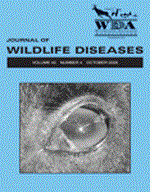A total of 164 blood samples, collected from free-ranging red deer (Cervus elaphus), roe deer (Capreolus capreolus) and fallow deer (Dama dama) in six German national parks (NP) between 2000 and 2002, were assayed for antibodies against nine viral disease agents. Antibodies were only detected against the α-herpesviruses; specifically, bovine herpesvirus-1 (BHV-1) (22 of 157, 14%), cervid herpesvirus-1 (17 of 157, 10.8%), and caprine herpesvirus-1 (11 of 159, 6.9%). Titers ranged from 4 to 102. Most of the seropositive sera, and those with the highest antibody titers, were from red and roe deer in the Harz and Hochharz NP, which are connected and allow migration between the two. The distribution and specificity of antibodies detected in individual deer suggests that the three α-herpesviruses are circulating in these deer populations. No antibodies were detected against bovine viral diarrhea virus, epizootic hemorrhagic disease virus, bovine leukemia virus, bluetongue virus, foot-and-mouth disease virus, or sheep and goat poxvirus.
How to translate text using browser tools
1 October 2006
Serological Survey for Potential Disease Agents of Free-ranging Cervids in Six Selected National Parks from Germany
Kai Frölich,
Chris Hamblin,
Satya Parida,
Eeva Tuppurainen,
Elvira Schettler

Journal of Wildlife Diseases
Vol. 42 • No. 4
October 2006
Vol. 42 • No. 4
October 2006
Bovine herpesvirus-1
caprine herpesvirus-1
cervid herpesvirus-1
free-ranging deer
Germany
national parks
serologic survey




